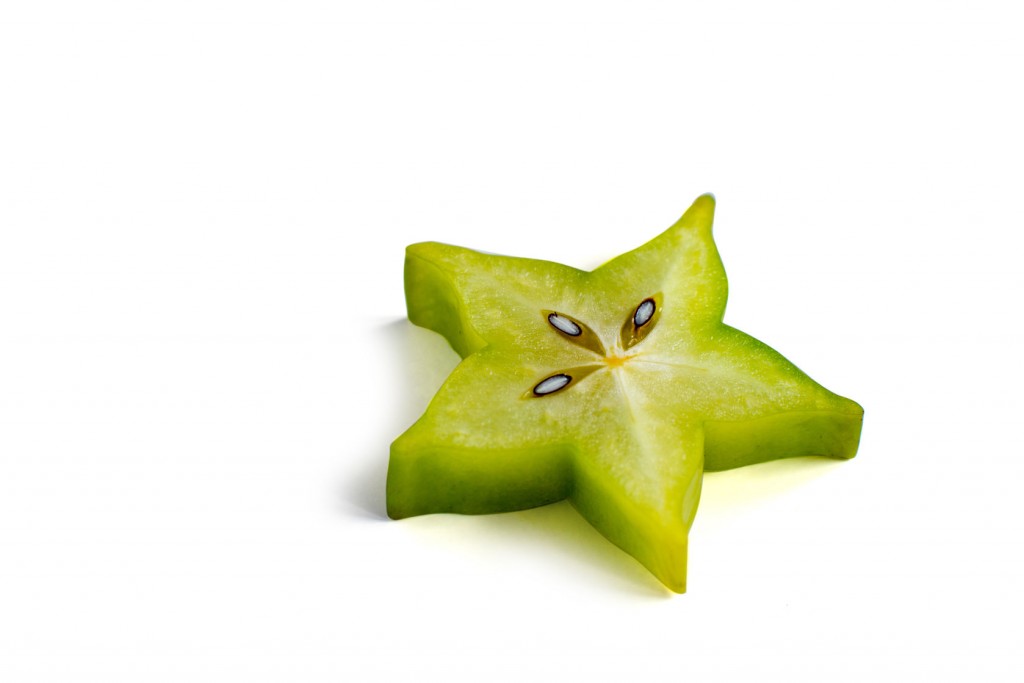A new series, in which we tell you what to do with that food item that you have no idea what to do with (or even what the heck it is). Hopefully you’ll find something new — and some new ideas of how to use it.
Starfruit, Also Known As Carambola
What Is It?
You might more commonly know the carambola as the starfruit, due to its unique five-pronged look (although the number of points can vary from four to as many as eight). With waxy skin and juicy flesh, it has proven popular in Southeast Asia and the South Pacific – countries like the Philippines, Indonesia, Malaysia, Vietnam, Bangladesh, India, and Sri Lanka, where it is commonly grown. It has been cultivated through Latin America, the Caribbean and the United States, although it has not yet reached the level of popularity here that it has throughout Asia or, much more recently, in Australia.
When ripe, a starfruit is typically a bright or pale yellow (vibrant green means it isn’t ready to consumption yet) and usually weighs 75-130g. Orchards of carambola are usually ready to be harvested after 3-4 years and can yield both mildly sweet and extremely sour varieties depending on various growth circumstances.
Is It Healthy?
Very much so — but with caveats. Starfruit is very low in calories, with 100g (three and a half ounces) of the fruit providing just 31 calories — much lower than other tropical fruits. Elsewhere, it can provide up to 57% of your daily required Vitamin C, as well as an assortment of essential nutrients, antioxidants and other vitamins. The peel and flesh are also high in fiber. Unlike many other fruits, starfruit is high in iron. Medically, carambola has been known to be used as a home remedy for hangovers, sunburn, and sunstroke (combine the two and have a tropical starfruit party!). In some parts of the world like Brazil, the fruit is used as a diuretic, to suppress coughs and relieve sore throats, and to even enhance the flow of a mother’s breast milk. It has also been known to help with stomach ulcers, skin inflammations (its high levels of zinc suggests it can be a natural way to fight acne), fevers, and digestion. Research also suggests carambola helps reduce cholesterol.
Conversely, due to the high level of oxalic acid found in the fruit, carambolas have been known to sometimes work as an anti-nutrient, interfering with the absorption of nutrients such as calcium and magnesium. It’s also been known to interact adversely with many drugs, and those with impaired kidney function are advised to not eat this particular fruit.
What Do I Do With It?
Its edible skin and flesh, coupled with its user-friendly design, make eating it out of hand a popular method, but juicing is also common. Starfruit’s appearance make the fruit perfect as an edible garnish on salads, tropical-flavored sorbet, or cocktails. Given that they can often be quite tart and sour, in these circumstances it is best to use them minimally.
One of the best uses of the starfruit, however, is as a chutney that can be used to add a tangy punch to pork, chicken, or fish, or even as a cooling side to a spicy rice dish. To make about two cups’ worth of chutney, you will need:
- 2 cups cubed starfruit
- ¼ cup sugar
- ½ cup of a dry red wine
- 1 tbsp finely chopped peeled gingerroot
- 1 tsp ground cloves
- 2 tbsp white wine vinegar
To prepare, simply follow this recipe:
- Add all ingredients to medium saucepan.
- Bring to a simmer over a medium heat and cook for 25 minutes.
- Use hand blender to smooth the mixture.
- Continue simmering until thickened.
Before preparation, be sure to handle these fruits with care as they bruise easily.
Where Do I Get It?
Make sure you purchase them from a greengrocer who will likely have more knowledge about the variety they are selling. You need to know beforehand if the starfruit you’re picking up is sweet or sour and tart.


























